by Admin Mediterra | Sep 26, 2020 | Skill Learning
There are so many details to the full choreography of swimming which we attempt to capture in our long menu of training cues. In your lessons you have been introduced to a selection of those, and we understand how overwhelming even that first encounter can be. How does one memorize all those cues?
We don’t expect you to remember them at the start. Those that are most useful to you will be memorized because you use them often enough. But there is a way to help your memory and keep your cues organized according to their priority in your skill development.
We recommend that you divide the body into these three sections and then any cue you encounter can be associated with one of these sections.
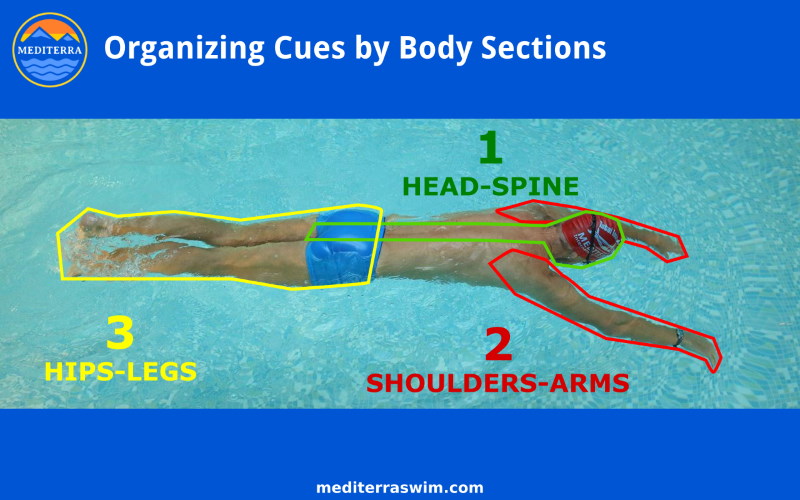
If you are working on your stroke and can’t quite remember the cue you were introduced to previously, you can consider what you need to do with a section of your body, in this order of priority:
- Head and Spine
- Shoulders and Arms
- Hips and Legs
As you start to think specifically about a section of the body, it will be more likely that your brain will recall a cue or something your coach said about that part of the body.
by Admin Mediterra | Sep 25, 2020 | Fundamental Skills
The entry and extension into streamline is how you deliver force into forward motion. The hand enters at a certain location, near the head, in front of the shoulder. It drives down into the water steeply, like traveling down the start of an Olympic ski jump. Then the arm begins to extend underwater, and its path levels out as it reaches target depth, straight in front of that shoulder. Then the arm continues to extend and reach, piercing the target, which brings your body into its best Streamline Position. Your body is lengthening and becoming more streamline with each microsecond. In this way, you receive the three forces from the recovery arm momentum, from gravity, and from the catch and convert all that into acceleration.
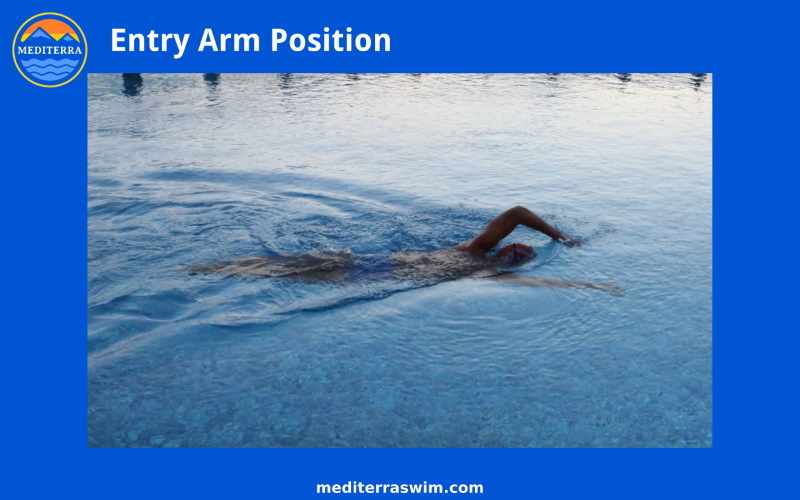
Below is an outline for how we form the entry and extension, and you will find some additional focal points and diagrams on the 101 Cues for Freestyle page under the Entry And Extension section.
The entry has a certain timing, a particular pathway and a certain smooth speed to make it most effective. The better your Entry and Extension into your best Streamline Position, the more that force is transferred into forward motion.
Let us reiterate this again so that it sinks in: The whole emphasis of the stroke is to Send Force Forward through the Recovery + Entry + Extension into Streamline. Everything else, including the catch, supports this primary action of sending the vessel of your body forward. This is the finish of the freestyle stroke. Treat this section of the stroke cycle as the important moment everything else has been preparing for.
Instructions
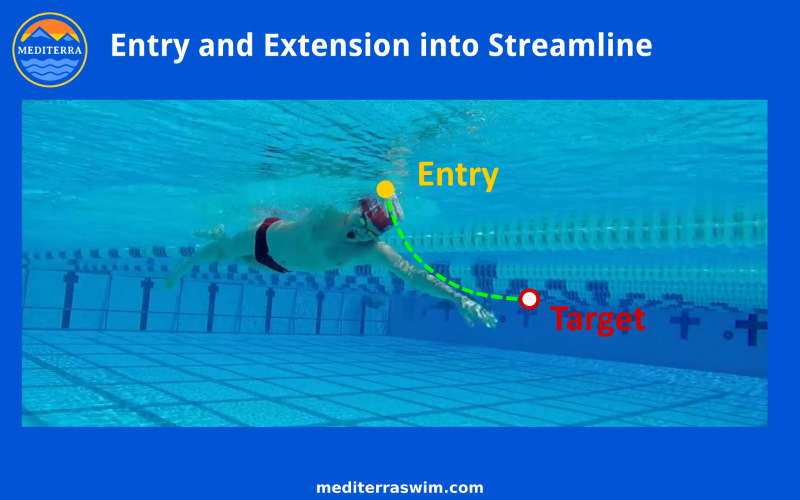
The forearm begins to enter close to the head, in front of the shoulder, with a steep angle, as if driving downward… at first. You are only going to start at a steep angle, but it will not stay this way.
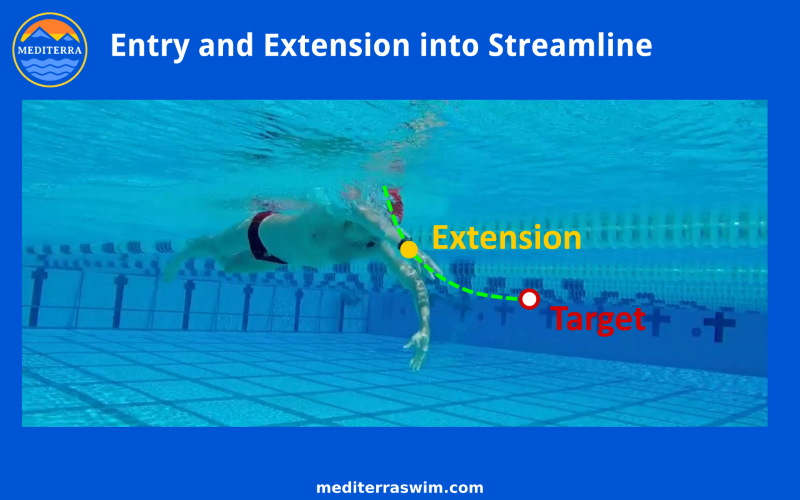
Remember, the goal is to Send Force Forward, the arm must be underwater as it extends toward the target. This requires an early entry position and a steep entry angle so that the arm can harness the rotational force of the torso into parting water molecules in front of the body.
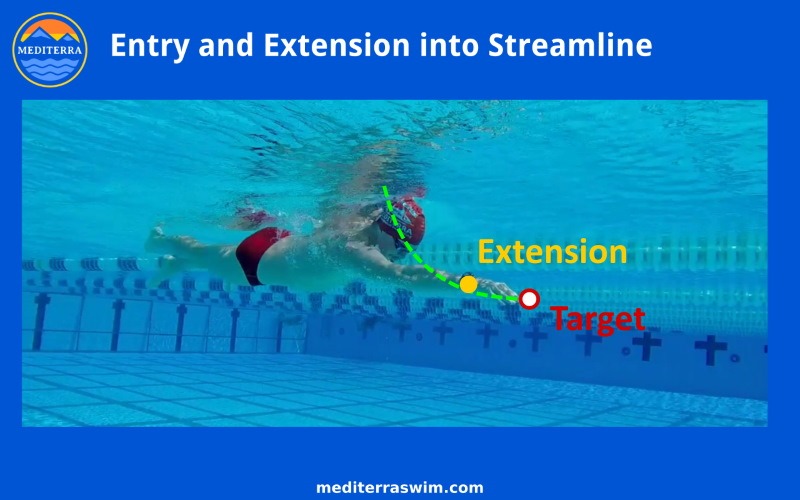
The arm drives down, on a curving path, to target depth and then levels out as it aims to pierce the target. The hand should come to a depth just below the lowest point of the body line. Notice that the emphasis of the lead arm is to stretch forward, not downward.
Notice how long and straight the body is on the streamline side. The swimmer is fully extended and continuing to emphasize the reach. He is not ‘twisting’ into an over-rotated position in order to reach. The side of the body is lengthening, as if he was going to pierce the target with his wrist.
Drills Useful For Entry Practice
- Standing rehearsal to create entry arm shape
- Recovery Swing, One Arm (swing to Entry Position and dip it a few times)
- 1-Arm Slot To Streamline (standing, with one arm in entry position, fall forward into Skate)
- 2- Arm Slot To Streamline (standing, with one arm in entry position, and one arm in Streamline Position, fall forward and switch arms, slide into Streamline)
Cues for Entry
- Elbow high above ear
- Elbow swings forward as far as comfortable
- Feel the stretch in the back as you reach entry position
- Forearm aiming straight ahead on track
- Forearm angling down (45 degree, like ski jump)
- Hand entry position across from opposite (lead arm) elbow)
Cues for Extension Pathway
- ‘Ski jump’ shape entry path
- Slide down to target depth and forward
- Spear wrist through your target
by Admin Mediterra | Sep 23, 2020 | Fundamental Skills
You may view the 101 Cues for Freestyle page, including additional cues for…
- Head and Spine
- Exit and Recovery
- Entry and Extension
- Rotation
- Catch and Hold
- 2 Beat Kick
- Breathing
by Admin Mediterra | Sep 22, 2020 | Fundamental Skills
Interrupted breathing is a technique you can use while working on other aspects of your stroke with drills or whole stroke. If you would like to focus on this breathing technique directly you may select 2 or 3 cues from the lessons and select a few of the activities listed below. We recommend that you work on turning into Interrupted Breathing on both sides, giving special attention to the side that feels weaker.
Activities
For all of the following activities practice an equal number of times to the LEFT and to the RIGHT.
Push off into Balance Position, then switch to Streamline, then roll to Interrupted Breathing.
Push off into Balance Position, then into Streamline, then roll to Interrupted Breathing, take 3 breaths, then roll back to Streamline.
Take three stroke, then roll to Interrupted Breathing.
Take three strokes, roll to Interrupted Breathing, take 2 breaths, then roll back to Streamline.
Take three strokes, roll to Interrupted Breathing, roll back to Streamline, then take 3 more strokes.
Swim a half length of the pool, and along the way, roll to Interrupted Breathing on the same side, twice.
Swim a half length of the pool, and along the way, roll to Interrupted Breathing, once on each side.
Swim a full length of the pool, and along the way, roll to Interrupted Breathing as needed, on the same side.
Swim a full length of the pool, and along the way, roll to Interrupted Breathing as needed, alternating sides.
by Admin Mediterra | Sep 21, 2020 | Fundamental Skills
In the first freestyle fundamental lesson we work on Building The Frame. This lesson will help you establish the first of our Four Essential Features of the freestyle stroke which encompass lengthening, balance and streamline skills.
And, here is the outline of the drills and attention cues, with links to video demonstrations of the drills. The following lists of activities and the lists of cues may contain more items than you experienced in your lesson. The instructor will watch the time and your pace of learning and choose a certain sequence of activities and the few most relevant cues for you to work with.
Drills
You may also consider using short swimmer fins to allow you to practice Scapula Slide Position with your legs more supported and the flow of water along your body. This flow of water may provide you with more feedback about how well you are maintaining form and a low-turbulence streamline position.
Cues
To help you pay attention, interpret and send commands to particular parts of your body your instructor gave you a selection of cues in each drill. There are more cues on the lists below than you were given in your lesson, as the instructor chose a few to get you going, without overwhelming with too many details. You may be able to figure out the meaning of the others you were not originally exposed to.
Cues for Torpedo
- ‘Mountain Pose’ (yoga) or ‘Stand At Attention’ (like military stance)
- Both hands tucked deep into pockets
- Elbow snug against your rib cage
- Long spine (as if pulled up by a string)
- Keep thighs straight behind torso
Cues for Balance Position
- Cues from Torpedo and…
- Neutral (aka Weightless) Head
- Tippy Toes (thighs straight behind torso, toes pointed gently)
- Arms On Wide Tracks
- Arm Straight (no bend at elbows)
- Hands at Target (below the depth of the face)
- Let arms hang heavy
- Shoulder blades (scapula) slide outward and forward (but not strained)
- Keep forearms soft (like a tree branch)
- Keep fingers soft
by Admin Mediterra | Sep 21, 2020 | Fundamental Skills
Practice Set for Build The Frame
Skills To Develop
- To maintain a neutral head position
- Hold long, straight, firm frame
- Keep arms connected to torso through the scapula
You want to feel your head and upper body fully resting on the support of the water. You want to feel your spine in neutral (good posture), from head to tail, including the legs streaming straight behind. You want to feel as if your body, from head to ankles, is one long, firm fuselage. You want to maintain this sensation as you take strokes.
Practice Set
Choose 2 or 3 of the cues from the lesson to work on today.
Then, for each cue, work through these activities, as far as you can go successfully. Take one cue and work through the list. Then take the next cue and work through the list again, and so on.
- 4x Balance Position (time of comfortable breath hold) examining one section of the body at a time.
- 4 rounds of starting in Balance Position for 3 second, then take 4 strokes
- 4 rounds of ‘6 whole strokes’ holding the same focal point (no breathing)
- 4 rounds of ‘4x whole strokes, Interrupted Breathing, 4x whole strokes’
by Admin Mediterra | Aug 6, 2020 | Skill Learning
It is a great feeling to work through an entire lesson series to achieve a new level of skill and fitness. But what does one do after this?
Below are suggestions for how you may continue developing your new swimming skills.
Will completing this course mean you have achieved mastery?
Not likely. But you will become a better swimmer this week than you were last week, and over time with this mindset you will become masterful. Don’t lose sight of how far you’ve come.
True masters of any art realize the fundamentals can be developed to deeper and deeper levels. But, even a new swimmer should experience a sense of ease and find their habits forming around these skills to the extent that they become your preferred way of being and moving in the water. You should experience your body sliding through the water better, and feeling like the same work requires less effort than it used to – perhaps quite dramatically so.
The stronger these fundamental skills become the easier it will be to develop advanced skills – like the Catch and the 2-Beat Press, synchronization of the entire body, and control over stroke length and stroke tempo.
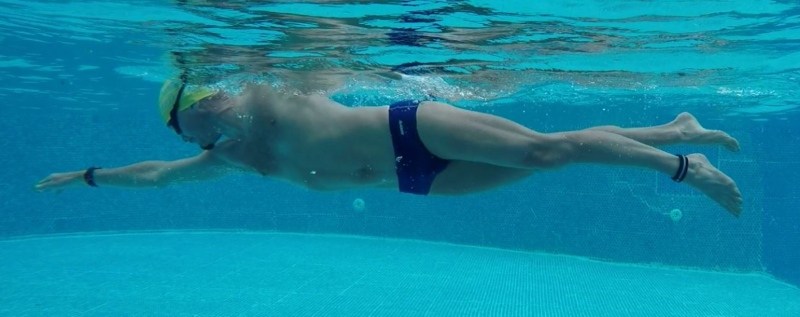
How do you measure success? Or when to move on?
Your quality objective in this course is to feel in control of your experience in the water – you feel more balanced, more aligned, more streamlined, and to feel that less movement is required to move forward. You know what to do to make those happen.
When you start to feel those sensations regularly, and feel capable of putting yourself into that state in each practice, then you may be ready to work on those advanced stroke skills. At that point you may seek out some private lessons, take one of our advanced live or online courses. Or you may learn from the patterns and principles embedded in each of our training courses, and study our Self Coaching 101 course and become your own best coach.
Repeat The Course Again?
The Freestyle Fundamentals course is meant to guide your integration of the fundamental skills for freestyle. You may want to extend your time in certain sections of the course. You may want to go back through the entire course, step by step, again. No doubt, those who do notice and learn much more than they did the first time going through it.
It is your mastery path. Take as long as you like, and go over the practices as much as you need to. Some skills might come quickly, while others take more time for your body to feel, improve and automate.
Moving on to Freestyle Advanced?
The stronger your fundamental skills, the easier it will be to develop the advanced skills, because they depend on them. However, working on your advanced skills can deepen your appreciation for the fundamental skills too, and show you where your strengths and weaknesses are.
It will only take a lesson or two of introduction to the advanced skills to help you know whether you are ready for the challenge of those or to keep working on fundamentals. It might be interesting and informative to work on advanced skills for a while and then go back to the fundamental skills with renewed appreciation and motivation to do more work there.
Take on a Fitness Challenge?
You might also want to apply your skills, as they are now, to work on a specific fitness challenge. Perhaps you want to become capable of swimming continuously a certain distance and you are eager to do that. That could be good also.
In our approach to training technique training is never separated from fitness training – all repetitive motion is training your body to move that way, and the more loading you place on those motions the more deeply that movement pattern will be wired into the brain. So, if you want your best movement patterns to show up in your distance swimming, you need to require those in all of your swimming.
If you follow any of our training plans for a distance achievement goal it will ALWAYS have technique standards built into every practice activity, and your progress in distance and intensity will be moderated by how well you can maintain your best movement patterns.
by Admin Mediterra | Aug 6, 2020 | Fundamental Skills
Skills To Build
- Hold stretched, straight, stable Streamline Position
- Wide recovery arm swing
- Elbow leads, moves forward continuously
- Momentum builds parallel to surface
- High Elbow at Entry
- Continuous, fluid motion, from Exit to Entry to Streamline
- Recovery Arm ‘lifts’ off the torso for a moment, almost weightless
- Have the entry arm be pulled in by gravity
- Have the entry arm slide in without a splash, no waves
- Have Lead Arm hold extended position until Entry
- Slide into your best Streamline Position
You want to feel your Streamline side of the body stretched, straight and stable, while your swing the recovery arm fluidly, without a sense of being rushed to do it because of instability. The more that you use the muscles in your torso to stabilize, the less you need your legs to move around to stabilize.
Choose 2 or 3 of the cues from the lesson to work on today.
Then, for each cue, work through these activities, as far as you can go successfully. Take one cue and work through the list. Then take the next cue and work through the list again, and so on.
Practice Set for Exit and Swing
- 4 rounds for each side, Swing Streamline for 6 seconds (time of comfortable breath hold)
- 4 rounds of ‘4x Swing Switch with pauses’
- 4 rounds of ‘4x Swing Switch without pauses’
- 4 rounds of gradually faster swing, gradually bring forearm out of the water
- 4 rounds of ‘6x whole strokes’ holding the same cue (no breathing)
- 2 rounds of ‘4x whole strokes, Interrupted Breathing, 4x whole strokes’
Practice Set for Entry and Extension
- 4 rounds for each side, Slot To Streamline
- 4 rounds for each side, Swing Streamline to Superman for 6 seconds (time of comfortable breath hold)
- 4 rounds of ‘4 to 6x Swing Switch with pauses’
- 4 rounds of ‘4 to 6x Swing Switch without pauses’
- 4 rounds of gradually faster swing, gradually bring forearm out of the water
- 4 rounds of ‘6 to 8x whole strokes’ holding the same cue (no breathing)
- 2 rounds of ‘4x whole strokes, Interrupted Breathing, 4x whole strokes
Progression From Drill To Whole Stroke
You may follow this progression in Streamline Switch Without Pauses to gradually raise the arm up above the surface (while fingers keep contact) while maintaining the qualities with cues:
- Full (relaxed) forearm is submerged
- Half of forearm is submerged
- Watchband is submerged
- (soft) Fingers are submerged, dragging through the water
- Fingernails are just brushing the surface
As a useful permanent standard, you may keep your fingernails every so lightly brushing the surface during your recovery swing, all the way to entry. I like to call this ‘dragonfly fingertips’, like a dragonfly skimming the surface of a pond.
by Admin Mediterra | Aug 6, 2020 | Fundamental Skills
Skills
The main skill is to have the body rotation empower the entry and extension of the arm on one side and empower the catch and hold on the other side at the same time. The well-timed body rotation will smoothly transfer power from the catch side to the streamline side and result in more satisfying sense of acceleration on each stroke.
The entry/extension arm will slide into the water and forward to its target as an expression of the body’s rotation. The catch arm will get a grip on the water and hold it, while the body rotates around that hold point and forward. All together, the catch will hold the water while the body rotation transfers the force it generates into the streamlining body on the other side.
You develop these connections by practicing the connection of one arm to the rotation. Then you some practice the connection of the rotation to the catch and hold. Then you practice connecting all three at once.
Note: we don’t teach the details of the Catch and Hold until Freestyle Advanced. The underwater catch (pulling) action you have currently is likely adequate for your purposes right now. We don’t want you to get distracted by that part of the stroke yet, because there are more important skills to establish first.
Drills
- Balance Position to Streamline (with weighted object in lead hand)
- Streamline to Streamline – 1 switch
- Streamline to Streamline – 2 switches
- One-Arm Drill
- One-Arm Swimming
- 6 whole strokes (no breathing)
- 6 whole strokes with 1 breath
- Whole strokes with breathing
Cues
Cues for Entry
- Weight shift
- Hold the scapula’s forward position
- Keep the armpit open to the deep
- Entry arm responds to the rotation
Cues for Catch
- Gather then rotate
- Hold and rotate
- Hold and slide past that point
- Slide the scapula back
by Admin Mediterra | Aug 6, 2020 | Fundamental Skills
Interrupted Breathing Introduction
Once you have learned Streamline Position, we may next introduce you to Interrupted Breathing (a.k.a. Sweet Spot Breathing). Interrupted Breathing is a way of turning to breathe from Streamline Position, while keeping a low-effort position in the water.
The intention behind this breathing position is to ‘interrupt’ the stroke but maintain long, balanced, streamline body, parallel to the surface, that is immediately ready to resume swimming when you are. It is the rest position that requires the least amount of effort to hold – lower heart rate, calmer breathing.
For this reason we teach it as a highly useful, if not essential self-rescue or self-calming position for children and adults, open-water swimmers and triathletes. Counter-intuitively, it works very well in rough water because you are staying down in the water, moving with the surface of the water as it moves, rather than going vertical and trying to lift your head above it, fighting its motion.
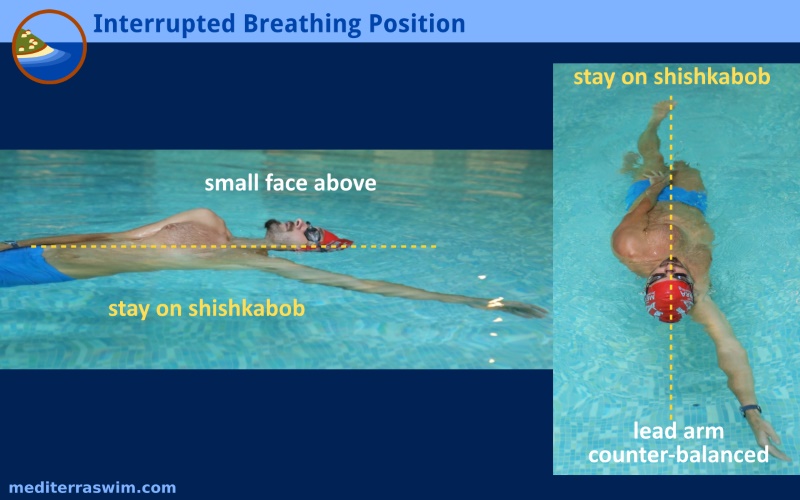
Interrupted Breathing is suitable:
- when using during drills that have you pause in Streamline Position
- when doing drills over a full length of the pool and stopping in the middle is disruptive to other swimmers
- when swimming whole stroke in the pool
- when in the middle of a race or rough water and you need to recover your breath and composure
You are encouraged to practice this breathing position and use it frequently because the better you can do this the easier it will be to develop Rhythmic Breathing – the skills for each overlap a great deal.
***
by Admin Mediterra | Aug 6, 2020 | Fundamental Skills
This is an outline of the main drills, cues we may use while introducing you to the Interrupted Breathing skill.
Drills
Here are some demonstrations of how to practice…
Cues
Here are the main cues to help you with critical parts of body position and movement…
- Turn towards open side (‘through the window’)
- Rotate head first – the turn of the head encourages the torso to turn
- Rotate with the Hip
- Keep head underwater as you turn
- Turn on the ‘shishkabob’ spine – keep head perfectly aligned with spine
- Bubble out from the nose until nose and mouth breach the surface
- Keep lead arm anchored deep as is comfortable (in Backstroke Streamline position)
- Keep the smallest face out of the water while breathing
- Relax head and neck once in neutral
- Water should brush the top of your goggles
- Exhale from nose as face rotates under
- Relax head and neck once in neutral
by Admin Mediterra | Jun 1, 2020 | Fundamental Skills
Practice Sets for Integrated Breathing
Skills To Build
• To maintain the First Connections
• To turn and return the head without disrupting that ideal stroke pattern
• To feel as little disruption to The Frame and Streamline Shape as possible
• To make breathing feel the same on either side
Breathing easily depends greatly on the strength of your stroke skills which support it. You want to feel your body long, straight, and firm in Streamline as you turn and return the head from breathing. The turning of the head should not disrupt the position of the body, nor force the movement of the recovery arm. Use the thrust of the catch and aim your body in Streamline to slide the upper body near the surface so the head is right there at the air already.
Practice Set for Integrated Breathing
Choose 2 or 3 of the cues from the lesson to work on today.
Then, for each cue, work through these activities, as far as you can go successfully. Take one cue and work through the list. Then take the next cue and work through the list again, and so on.
• 4 to 6x, for each side, Balance Position to Streamline with ‘Nod’
• 4 to 6x, for each side, Balance Position to Streamline with ‘Split The Face’
• 4 to 6x, for each side, Balance Position to Streamline with ‘Hooked Fish’
• 4 to 6x, for each side, 3 Strokes To Streamline
• 4 to 6x, for each side, 3 Stroke, 3-Part Breathing, 3 Strokes
• 4 to 6x, for each side, 6 Strokes with 1 turn to breath (no pauses)
• 4 to 6x, for each side, 9 strokes with 2 turns to breath along the way
• 2x length of pool, for each side, turning toward air on every 4-2-4-2 strokes
• 2x length of pool, turning toward air on every 3 strokes







